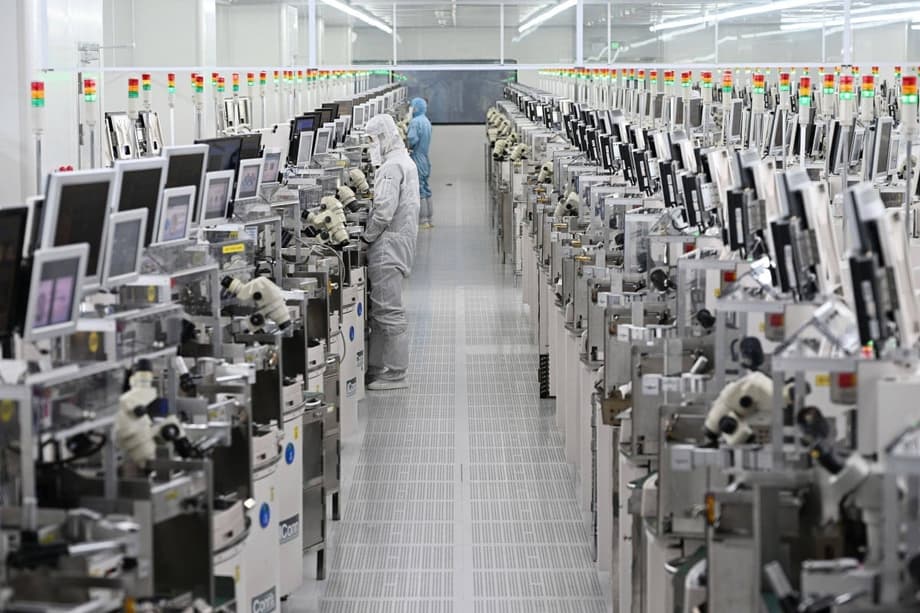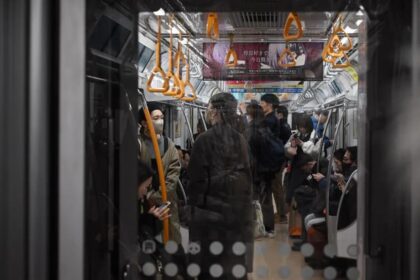Why this new photoresist insight matters
Chinese researchers say they have directly observed how photoresist molecules behave in the liquid films used during chip lithography, then turned that insight into a factory ready fix that slashes defects. The work, led by a team at Peking University with industrial partners, was published in Nature Communications on September 30, 2025. The team reports that its protocol reduced polymer residues on 12 inch wafers by up to 99 percent under real fabrication conditions, a change that could lift yields for 7 nm and smaller process nodes.
Photoresist is the light sensitive coating that defines the patterns of transistors and wiring on a silicon wafer. During photolithography, a scanner projects a circuit image into the resist. The exposed regions change solubility, then development and cleaning reveal the pattern. Minute residues or scum left behind can short lines, break contacts, and trigger failure during later steps. At advanced nodes with narrow lines and tight spacing, even a small cluster of molecules in the wrong place can kill a die.
China relies heavily on imported resists, especially at the high end. That dependence is one reason domestic fabs have struggled to push yields at the most advanced nodes. With top tier extreme ultraviolet scanners from ASML blocked from the Chinese market since 2019, domestic chipmakers have used multiple rounds of deep ultraviolet patterning to reach 7 nm class features. That method magnifies the role of the resist, because the wafer sees more exposures, more develops, and more wet cleans across dozens of steps. Any reduction in random defects pays off in more working chips per wafer.
What exactly did the researchers do
The Peking University team applied cryo electron tomography to photoresist films while the polymers were still in their native liquid environment. That imaging method freezes a thin sample extremely fast, locks molecules in place, then uses a transmission electron microscope to capture a series of tilted views. Software reconstructs a three dimensional map at nanometer scale resolution. Using that approach, the researchers visualized how resist polymers arrange and entangle in the bulk of the film and at the gas liquid interface during development and rinse.
Those images, paired with process experiments, pointed to a hidden source of residue. Long chains can knot together at the top of the film near the interface, then get trapped in pattern recesses during rinse and dry. Based on the maps, the team devised a protocol to inhibit polymer entanglement at the interface. They report that the change eliminated almost all residue related defects in an industrial setting on 12 inch wafers.
From biology to chipmaking, what is cryo electron tomography
Cryo electron tomography, often shortened to cryo ET, grew up in structural biology to image proteins and cells in their native shapes. The sample is vitrified, meaning water and solvents freeze into a glass like state without forming crystals that would disrupt the structure. A tilt series of electron images is then reconstructed into a three dimensional volume. The key advantage is that molecules are preserved in place instead of being dried or stained, which could move or damage fragile structures. Bringing cryo ET to semiconductor materials lets researchers observe polymers that normally slosh and rearrange in solution, finally catching them in the act of forming the networks that cause defects.
Why polymer entanglements create defects
During development, exposed regions of resist dissolve while unexposed areas remain to protect the underlying film. Entangled chains that span both regions can leave thin veils after development, a defect often called scumming. In trenches and contact holes, knots can lodge and resist the rinse, which shows up as residues that later interfere with etching or metal deposition. These are classic yield killers. They increase line edge roughness, cause microbridges between lines, and force rework. If too many features are affected, a wafer gets scrapped. The smaller the geometry, the more severe the problem, since a few nanometers of extra material can close a gap or change a critical dimension.
How this could change production yields at advanced nodes
Yield is the share of good chips that make it to the end of the fab out of the total dies patterned on a wafer. At 7 nm and below, a modern system on chip may contain tens of billions of transistors and requires hundreds of process steps. Random defects add up quickly. If a resist tweak removes a common source of residue across multiple layers, the effect multiplies through the flow. That can raise final yield by several percentage points, which in foundry economics is a large improvement in cost per good die.
Resist behavior touches more than the exposure and development. Etch selectivity, plasma damage, and wet cleans all depend on how the polymer network forms and how it breaks down. The research team says the same interface control that cuts residues in lithography also reduces defect carryover into etch and cleaning. That would help stabilize critical dimensions and line roughness, which in turn improves device variability and performance.
Fewer rework loops, more good dies per wafer
Foundries often loop wafers back through cleans or repair techniques to salvage yield. Each loop adds time, cost, and risk. If residues fall by 99 percent, the need for extra steps shrinks. That frees tool capacity, shortens cycle time, and lowers chemical use. For customers, fewer latent defects mean better reliability during burn in and field use. For chip designers, a tighter distribution of line widths and contacts gives more predictable timing and power.
Where this sits in China chip strategy
Materials and lithography sit at the center of China efforts to reduce reliance on foreign suppliers. Photoresist is a clear weak spot. Domestic vendors have made progress in mid range products for KrF and ArF tools, but high end grades remain dominated by firms in Japan, the United States, and South Korea. Industry estimates put the Chinese photoresist market at about 11.4 billion yuan in 2024 with continued growth expected in 2025. Global demand for photoresists was valued near 2.7 billion dollars last year and could reach 4.5 billion by 2031, reflecting rising layer counts and tighter design rules.
Policy makers have targeted materials in the newest funding round of the National Integrated Circuit Industry Investment Fund. Analysts report that Phase Three includes more than 50 billion yuan for chemicals, resists, and related processes, alongside investment in tools and equipment. Setting shared rules is part of that push. The Standardization Administration of China has issued a national test specification for extreme ultraviolet photoresists. Common test methods help universities and companies compare results, qualify suppliers, and prepare for pilot manufacturing.
Universities and companies push new materials
Chinese universities and startups are also pursuing new chemistries for the extreme ultraviolet era. A Tsinghua University team reported a polytelluoxane resist in July that builds tellurium atoms into the polymer backbone to boost absorption at 13.5 nm. The Te O bond cleaves more easily under exposure, which can raise sensitivity while keeping molecular weight low to improve resolution. If that material scales, it could offer a domestic route to extreme ultraviolet patterning with better tradeoffs among sensitivity, line roughness, and outgassing.
On the corporate side, a materials arm of SiCarrier presented a metal cluster resist that patents describe as based on tin oxide clusters, with claimed patterning from 3 nm to 50 nm. Those claims need independent validation in a foundry line, but they point to a broader trend. Chinese firms are stepping into the resist race while tool makers expand domestic lithography options. A new spinoff from Shanghai Micro Electronics Equipment showcased steppers for compound semiconductors, laser annealing systems, and inspection gear. The country still lacks access to advanced extreme ultraviolet scanners from ASML, yet the ecosystem is moving to fill gaps in materials, metrology, and design software.
What this breakthrough is, and is not
The Peking University result addresses a very specific pain point, the behavior of resist polymers in liquid films and at the interface with air during development and rinse. By imaging those structures directly and altering how they form, the team proposes a way to cut a common source of contamination. That is valuable because it shortens process tuning and reduces trial and error, two chronic sources of delay when a fab brings up a new node.
It is not a replacement for state of the art scanners, masks, and resists that are needed to reach the smallest geometries. Extreme ultraviolet lithography introduces challenges that go beyond residues. The light source has limited brightness, shot noise leads to random variation in line edges, and the resist must trade off sensitivity against line roughness and pattern collapse. Masks need pellicles that survive high energy light, and contamination control is demanding. Interface control will help, yet Chinese fabs will still be constrained by the tools they can buy and build.
The claims also need broad verification. A 99 percent reduction measured in one environment may not translate to all resists or to every layer. Different pattern densities, developers, rinses, and etch chemistries interact in complex ways. The next step is replication across multiple fabs and processes, with device level data that ties residue cuts to higher final yield and reliability.
Next steps for research and industry
Several milestones will show whether this advance reshapes production in practice. First, independent fabs and materials suppliers can test the protocol on common ArF immersion and dry extreme ultraviolet stacks and publish process windows. Second, foundries can report how much rework shrinks and how line edge roughness and critical dimension variability improve when the method is applied to critical layers. Third, equipment and chemical vendors can propose tool settings and formulations that bake the interface control into turnkey recipes that customers can adopt without major changes.
Policy signals in China point to continued investment in photoresist materials. The national test standard for extreme ultraviolet resists should make it easier to compare performance and qualify lots. University programs, including work at Tsinghua on tellurium based polymers, keep the talent pipeline active. Companies are starting to show a mix of scanners, inspection systems, and new resists in public forums, which suggests more pilots are coming. Outside China, government backed programs in the United States, Europe, Japan, and South Korea are putting billions into chip research. Competition in photoresist science will likely tighten as each region tries to control more of the materials stack.
Key Points
- Peking University and partners used cryo electron tomography to image photoresist molecules in liquid films and at interfaces, then designed a process that the team says cut polymer residues by up to 99 percent on 12 inch wafers.
- The work was published in Nature Communications on September 30, 2025, and targets yield losses at 7 nm and smaller nodes where tiny residues can kill dies.
- China remains dependent on imported high end photoresists and lacks access to advanced extreme ultraviolet scanners from ASML due to export controls.
- China has moved to support materials with funding and standards, including a new national test specification for extreme ultraviolet photoresists.
- Tsinghua University reported a tellurium based extreme ultraviolet resist, and Chinese firms have showcased metal cluster resists and domestic lithography tools, though many claims await independent validation.
- The breakthrough improves understanding and control of resist interface behavior but does not remove the need for advanced scanners, masks, and next generation resists.












